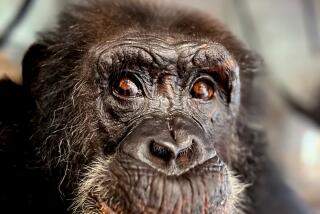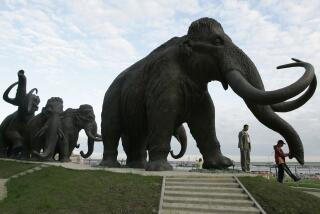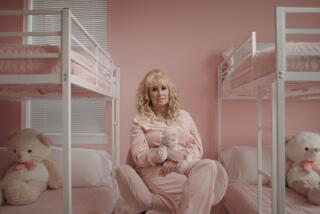San Diego Zoo Hopes to Craft an Ark for Endangered Species
SAN DIEGO — How do you prevent dik-diks from cross breeding or determine if a panda is pregnant? What’s the secret to get northern white rhinos to mate or the best living space for sexually active cheetahs?
These questions come from the inquiring minds of about 30 researchers who use the techniques of a crime lab and the tools of a sperm bank at a sex clinic for endangered species.
From analyzing DNA to sawing off rhino horns, researchers at the San Diego Zoo’s Center for Reproduction of Endangered Species are trying to save animals on the brink of extinction and collect genetic fragments of those that might not be around in 50 years--a modern Noah’s ark for the 21st century.
“We really do believe in a whole-animal approach,” said Barbara Durrant, chief of the reproductive physiology division. “We realize reproduction can be affected by nutrition, disease, endocrinology, behavior and physiology.”
One of the first of its kind in the world when it opened 20 years ago, the center now operates on a $2-million annual budget in a 70-year-old building behind the zoo’s duck exhibit.
In two separate buildings--to prevent a total loss in case of fire or other disaster--six freezers hold viable samples of semen, eggs and tissue cells at 425 degrees below zero.
Future scientists will contend with the frozen samples, but current researchers are using their knowledge to save animals on the brink of extinction today.
“If we didn’t save it, it’s gone forever,” Durrant said. “We don’t necessarily have a plan. We just know we have to collect it.”
Because animals are heading toward extinction at the rate of about one a day, center researchers cannot rely on tomorrow’s technology. They try to use what is known about the animals’ behavior, physiology, hormones and diseases to develop a plan that works now.
Their most earthshaking success came late last year when a pair of amorous northern white rhinos finally mated--something never accomplished by the captive rhinos whose numbers have dropped to about 40 worldwide.
An event six years in the making, it involved research from nearly all the center’s divisions, Durrant said.
By analyzing droppings, endocrinologist Nancy Czekala-Gruber found a female rhino named Nola had normal levels of hormones. But she was acting too aggressively toward males, so physiologists had her horns sawed off.
“We felt that if we took the horns off the females, we could decrease the aggressive reactions of the females toward the males,” Durrant said. “With one male, it didn’t work, but we introduced another male.”
Three months later, Czekala-Gruber is still trying to figure out if Nola is pregnant.
“If you wanted to monitor the reproduction of a dog or a human, for instance, you’d go to the doctor and they’d take a blood sample and they’d measure hormones to tell you whether you’re pregnant or infertile,” Czekala-Gruber said.
“With exotic animals, you can’t do that, so we have to take samples that are left behind,” she said, opening a refrigerator door to reveal a collection of gray rhino droppings.
Hormone analysis through fecal and urine specimens has also helped center scientists work with giant pandas, rare apes and other species.
Some of the research also has helped humans. For example, women can now have their urine rather than their blood tested to determine fertility--a procedure first developed for apes at the center.
For decades, scientists had been stumped by the failure of most captive cheetahs to mate. It was believed to be caused by the poor quality of cheetah sperm.
“But logically it doesn’t make a lot of sense,” said Don Lindburg, chief behaviorist. “I now have data that says it is not a problem with the animal; it’s a problem with the people who manage the animal.”
Lindburg found that cheetahs are solitary creatures who rely on scent to find their mates, a process that works in the wild but fails when the animals are kept together in cages.
“We found that if we did not put them with the female until they were sexually aroused, they responded to her with courtship as opposed to aggression,” he said. “What does a solitary mammal do when its space is invaded?
“It either moves away or, if it’s his own space, there’s a confrontation, an aggressive response.”
Lindburg did his research at the San Diego Zoo’s Wild Animal Park, a 2,200-acre preserve where animals roam free. In tests of a dozen cheetahs over 10 years, 11 animals mated, resulting in a pregnancy rate of about 80%. The rate at other zoos was about 20%.
Sometimes animals become pregnant and produce infertile offspring. Other times, researchers are unsure which animal is the father.
In these cases, researchers use the same tools as a crime lab to study the animals’ genetic makeup.
Late last year, the pharmaceutical company Perkin-Elmer donated a $100,000 gene sequencer to the center to examine the genes that give animals certain characteristics and help identify lineage.
In the case of the threatened dik-diks, a type of antelope, it explained why some produced infertile offspring.
By examining their DNA--the building-block molecule of life--scientists determined they were breeding two closely related species of dik-diks. Such cross breeding caused the infertility.
Scientists also have been able to determine how certain gorilla species are related.
“That gives us some insight into the sexual politics of gorillas and more understanding about their society and biology,” said chief geneticist Oliver Ryder. “We can do a better job of conserving things we know about, given the limited resources in terms of space and habitat.”
Ryder and other geneticists have started a program similar to the Human Genome Project, which seeks to catalog all human genes.
The wildlife project brought the geneticists full circle.
“It’s incredible that billions of dollars are being put into the Human Genome Project, and yet until we understand how different we are from the chimpanzee and the gorilla, we won’t even know what’s human about the human genome,” Ryder said. “Every time someone gets some interesting new gene, they want to understand how it evolved.
“They want to get some DNA from a chimpanzee or a gorilla.”
More to Read
Sign up for Essential California
The most important California stories and recommendations in your inbox every morning.
You may occasionally receive promotional content from the Los Angeles Times.










